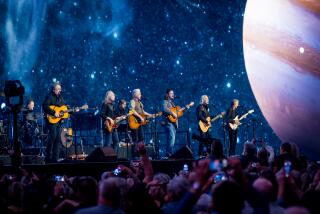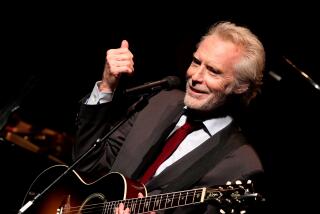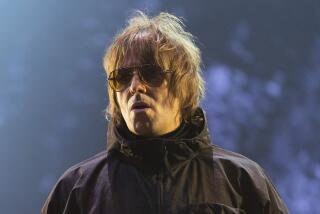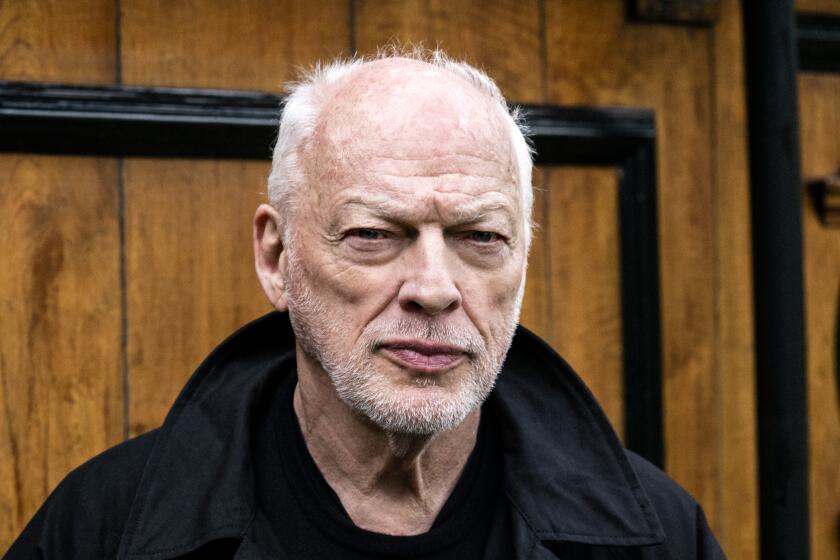Life in the Fast-Buck Lane: Enough Already!
- Share via
I’ll admit this much: Nobody who came to Irvine Meadows to see the Eagles got ripped off.
But anybody who thinks that rock music should stand for something besides business as usual got let down.
The Eagles sized up their market and set their price. Some 75,000 people paid it, and tens of thousands more probably would have done the same if there had been enough tickets to go around.
It was a classic scenario from Economics 101: pent-up demand (these were the reunited band’s first tour dates in 14 years) and limited supply (a five-night stand at the 15,000-capacity amphitheater) conspired to drive prices up.
In fact, the ticket prices were unprecedented for a rock concert that was not a benefit: $115 for orchestra seats, $75 for seats in the two higher tiers, and $35 for a spot on the lawn. Those were the face values. Ticket brokers were asking more than $80 for the lawn, and more than $500 for the front rows.
In return, the Eagles delivered a long, sharply played, well-sung performance that, aside from the omission of a couple of their early hits, should have been enough to meet the expectations of any confirmed fan.
The Eagles played the system the way the business textbooks say it’s supposed to be played: A desirable product, skillfully wrought and painstakingly presented, yielded an economic triumph to the tune of approximately $1 million a night in gross ticket receipts.
Except that rock ‘n’ roll is supposed to be more than grease for the economic wheels. It is supposed to be popular music in the broadest sense: a music of the people, priced in a way that is not patently unfair to the teen-aged burger-flipper, the college student pressed by rising fees, the sales clerk or medical office assistant, the cop or the machinist.
At a time when the urge for short-term profit maximization in American business is putting good, hard-working people out of work, we need respected voices to call for moderation, to remind us that not all value should be measured in dollars.
*
The Eagles had a chance to deliver that idealistic message without sacrifice, simply by charging the going rate for a top-of-the-line rock show.
At a hefty but not unusual average ticket price of $30, they could have grossed $450,000 a night. Even writing off half the take to promoters’ fees, venue rental, crew salaries and other overhead expenses, each of the five band members would, in one night , have earned more than the national median annual family income of $39,700. And that doesn’t count their cut from merchandising, concessions, Ticketmaster fees, and whatever other lucrative add-ons might have been in effect.
Instead, the Eagles went for that cool million at the box office. The average ticket price of $67.85 sent the message that self-restraint and a healthy sense of moderation are for saps.
Forget all that communitarian, music-for-the-people stuff. What counts is to set up the big score, then press your advantage as hard and as ruthlessly as you can. After all, it’s a free market, and if the market supports it, then it must be OK.
The Eagles are not the only offenders. Rod Stewart was the first rocker to hit the $100-ticket mark in Orange County, with his April shows at The Pond of Anaheim. Traffic is commanding $65 for a top seat at The Pond.
Barbra Streisand played the game of supply and demand even more avidly than the Eagles, pricing her Pond shows at $350, $125 and $50. But Streisand is no rocker, with the messy populist and egalitarian antecedents and agenda that a rock heritage entails.
She is a pop diva, the cultivator of a cult of personality, and she comes from a Broadway tradition in which the audience is expected to pay royally for the privilege of a regal presence.
One favorite argument in favor of pricing prime concert tickets at $50 or more is that scalpers get far more than that, so why shouldn’t the promoter and artist reap something closer to the ticket’s actual market value?
*
That is a persuasive argument if the assumed aim of a rock concert is profit maximization. But if you buy the notion that pricing structures should reflect rock’s populist traditions and take into account average people’s ability to pay, you don’t join the scalpers; you fight them.
Ticket scalping should remain exactly what it is: a distortion of the market that exists because a substantial number of people with too much money or too much zeal are willing to pay unreasonable prices for the entertainment they covet. Artists and promoters who use this distortion of the market as an excuse to redefine the market upward are making it impossible for anyone to buy a good seat at a fair price.
There’s a simple way to determine a populist price ceiling for rock concert tickets: Gear the cost of a ticket to the cost of a record album.
The average compact disc contains about 50 minutes of music and retails for $14 or $15. Therefore, the average 100-minute rock concert should carry a top ticket price of $28 or $30 (artists playing longer shows should be generous and throw in their encores for free rather than push prices higher).
An even better way for rockers to show solidarity with their audiences would be to gear prices to the prevailing wage in a community. If the average worker makes $12 an hour, bands might consider setting ticket prices at $24 for a two-hour show.
At these rates, rock stars won’t go poor. By running their careers under principles that shun the big score and take into account the economic limitations that most of their audience has to live with every day, rock stars could make something of their tours besides business as usual. That would raise their worth in a way that can’t be achieved in a box office bonanza.
*
At the same time, it would help if rock fans could also develop a sense of moderation and proportion.
One way is to remember that it isn’t a disaster if you miss a concert by your favorite big name. Set limits on what you’ll spend.
Another way is to realize that some of the most fulfilling rock ‘n’ roll experiences are not big-dollar events by household names.
To keep my own sense of proportion during this blitz of Eagles this and Streisand that, I went to see the Missiles of October last Thursday night. The venue was the Marine Room Tavern, a clean, comfortable and very cozy bar in Laguna Beach. The cover charge was $2 for a three-hour performance.
The Missiles are four veteran Orange County players who all began their careers in the early 1970s, around the same time the Eagles were getting together.
Poul Finn Pederson, Bob Hawkins, Frank Cotinola and Jimmy Perez may be fated to earn their livings in small local bars rather than arenas and amphitheaters.
If they are lucky, the Missiles’ regimen of three or four shows a week enables them to scratch out a livelihood somewhere on the lower fringes of the middle class. In terms of pride and skill, though, I don’t think they give away anything to the Eagles.
Don Henley is a remarkable singer--but so is Pederson, who through the three 45-minute sets I saw did not stint on soulfulness or intensity. Hawkins is a marvelous guitar player. While I enjoyed most of Don Felder’s playing, and some of Joe Walsh’s, I’m not sure either of the Eagles’ lead guitarists could top the unflagging flow of tasteful, inventive playing that Hawkins mustered almost as a matter of routine.
The Missiles don’t have a record out, let alone any hit songs, so they play bars like the Marine Room (Thursday nights and Sunday afternoons, (714) 494-3027--and the Old Town Mexican Cafe in Dana Point (Friday nights, (714) 496-2560).
But they do have legitimate hopes of getting out of the bar scene and onto a national touring circuit. If Henley and Glenn Frey were to come up with a song as strong as the Pederson original “Look at Daddy Run” or “Bad Seeds,” a song that Eagles songwriting associate Jack Tempchin directed to the Missiles, I don’t think the Eagles would throw it back.
But the big world doesn’t know about that. Not yet, anyway.
“Sometimes we feel like we’re just another bar band, and we have to remind ourselves that we’re not,” Pederson told me during a break.
Sit through a few Missiles sets, and their adventurous interpretation of well-chosen, never-obvious cover material can become a graduate seminar in intelligent rock.
Last Thursday, Pederson called tunes by Richard Thompson, John Prine, NRBQ, John Hiatt, Bob Dylan and Bruce Cockburn. The band served up zestful R&B;, rocketing country-rock, and reinvented Willie Dixon’s swaggering blues boast, “Seventh Son,” as a deeply felt folk-ballad lament. There wasn’t a lot of talking in the bar, because the tug of the music was strong.
During a funky version of the subdudes’ “Poverty,” four women formed an impromptu chorus line along the back wall, doing Motown-style dance steps. They were high-school teachers from San Juan Capistrano, three of them first-timers who had come to see the Missiles on a tip from the fourth, a Marine Room regular.
A teacher named Tracy (they were shy about giving their last names, not wanting to be pegged as revelers on a school night) said one of her colleagues had come in with the attitude that great rock doesn’t happen in humble places.
“She said, ‘I feel like I’m slumming.’ And then she got caught up.”
Try it.
World-class local talents like the Missiles of October, Chris Gaffney, Jann Browne, Walter Trout, Eli Riddle, James Harman and Joyride are out there, playing for cheap and playing well. You, too, might get caught up in the pleasures of discovering a rare talent for a couple of bucks.
You might find that these easily accessible local alternatives make things a lot easier to take when the laws of supply and demand cut you out of the superstar concert market.
The next time some high-flying rock band wants you to shell out $115 or $75 for a seat and $35 for a steeply sloping patch of grass (not to mention Ticketmaster’s onerous processing fees), you’ll know where to tell it to go. And you’ll know where you can go instead.
More to Read
The biggest entertainment stories
Get our big stories about Hollywood, film, television, music, arts, culture and more right in your inbox as soon as they publish.
You may occasionally receive promotional content from the Los Angeles Times.











